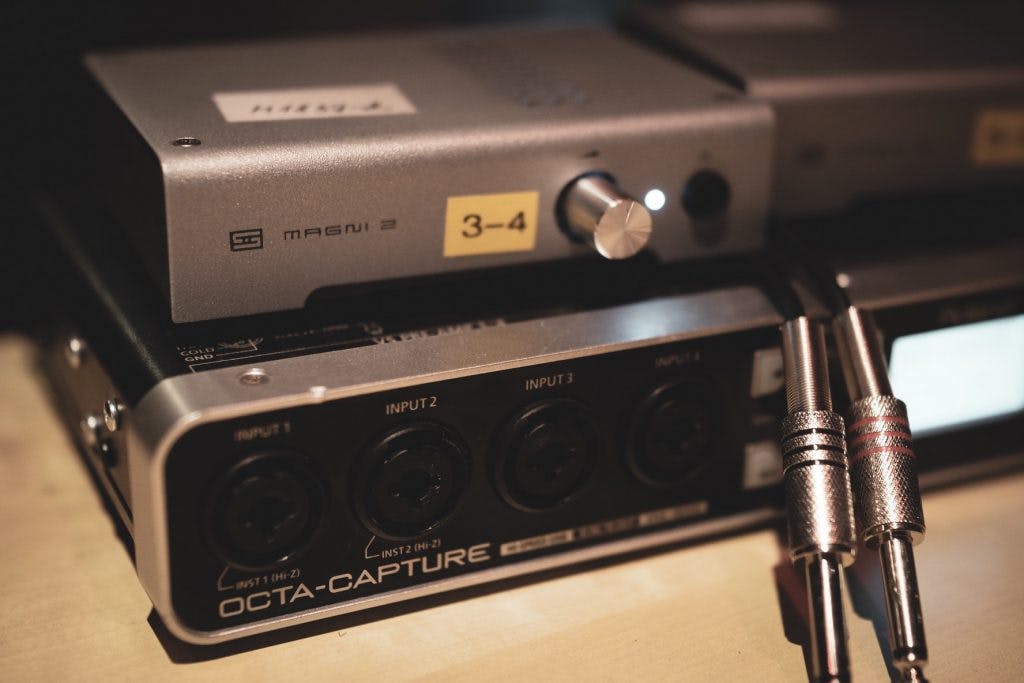So, you’re hungry for power? Let’s hope you’re hungry for knowledge as well, because here you will find out what’s a headphone amplifier and when it’s useful to use one. SPOILER ALERT: It’s totally fine to get one even if your audio interface is good enough.
What’s a headamp?
Before we deep-dive into the intricacies of amplification, it’s useful to look at what the modern digital audio chain looks like. First there’s digital-to-analog converter (DAC) which interprets the digital datastream and turns it into an analog signal. This signal can then be taken by an amp and fed to a speaker or headphones so the sound can take flight to your eardrums.
Any amplifier is first and foremost a control device which uses electrical signal to control the motion of membranes in your headphones. Everyone who has driven a modern car has had a very hands-on experience with an amplifier – power steering is a mechanical amplifier which measures the motion of the steering wheel and then uses an electric motor to help you turn it with less effort. In the same manner a headphone amplifier measures the signal transmitted by the DAC and then usually creates a higher energy copy of the signal for your headphones. Sometimes, however, a headamp used to drive super sensitive IEM’s can actually attenuate signal it gets from the DAC.
A headphone amplifier is present in every device which has a headphone jack. In a cell phone or laptop the DAC and headamp can actually be found in a same chip. Usually it’s done this way to reduce the cost and complexity of a circuit. In most audio interfaces headphone amplification will be done with a dedicated opamp chip. These tiny pieces of electronics vary both in their ability as much as in their cost. As headphone use for audio engineering has boomed over the years, so have audio interface manufacturers paid more attention to headphone output quality and power capability.
Why use a headamp?
There are generally two rational reasons why to use a dedicated headphone amplifier in a studio. First is kind of obvious – if the headphone output of your audio interface can’t drive your cans to a sufficient SPL, then getting a beefier amplifier is a good option. For best results hook up the headphone amplifier to a line-out signal, rather than the default headphone output, so that you’re not double amping. Truth be told, nowadays only a very small portion of headphones can’t be driven sufficiently loud from a phone, laptop or audio interface headphone output.
Second reason why one should look for a dedicated headphone amplifier is quality. If the headphone output of your laptop or audio interface is noisy or audibly distorts at higher volumes, then a headamp can help. Just take care to check what’s the source of the noise, otherwise it can be smarter to get a better audio interface or a separate DAC and amp unit for headphone monitoring.
There’s also a third reason. Whilst the first two were purely rational reasons, the third isn’t – it’s always okay to get a headamp if you really want it! If a piece of gear makes you happy and inspired, then by all means – get a nice headamp to complement your setup. If your headphones are high impedance, then even tube headphone amplifiers become an option. Just keep in mind that due to their high-ish output impedance they can emphasize lower mids on some headphones.
General recommendations
So, you’ve decided you need something better for headphone monitoring? There are some things you need to keep your eye on. If you’re combating a noisy headphone output, be sure to not hook up the amp on the same noisy output. It also makes sense to find out whether the amp you have your sights on has low output impedance. Generally anything less than 5 ohms should be okay, unless you plan to drive IEM’s or other very low impedance headphones out of it.
Despite being popular in the pro audio circles, stay clear of distribution amplifiers for headphones. They’re made for ruggedness and convenience, rather than quality. Many are noisy and can have rather high output impedance. It would also be smart to check if the amp you’re eyeing has selectable gain. If your headphones are sensitive, then you might be forced to keep the volume knob turned down, which is where many analog volume controllers have channel imbalance. In terms of frequency response almost every solid state amp should be more than sufficient, same goes for harmonic distortion.
Here are some recommended products we use or have used here at Sonarworks.

Purely amps –
- Schiit Magni 3 – affordable, transparent and extremely powerful. Has a gain switch which allows it to be used with many different headphones. As a rule of thumb – keep the gain down and volume up, rather than vice versa.
- Massdrop X THX AAA 789 – one of the more transparent and low noise amps out there. If you have a dedicated high-end DAC, then this is a perfect companion for immersing yourself into the densest of mixes. Of course, you’ll need a sufficiently good set of headphones as well…
Combo DAC and amp units –
- Schiit Fulla 2nd gen – less powerful than the amp-only Magni 3, but gets you a nice DAC as well. Surprisingly feature-rich and will work on USB power.
In conclusion
Make no mistake, a better headphone amp won’t catapult you instantly into Grammie-dom. In the studio it’s more of a convenience accessory which should keep out of the way. Does it impact the way your headphones will sound? It can. However the sonic impact of a headamp will be orders of magnitude lower than that of the headphone or even the DAC that feeds the signal.



